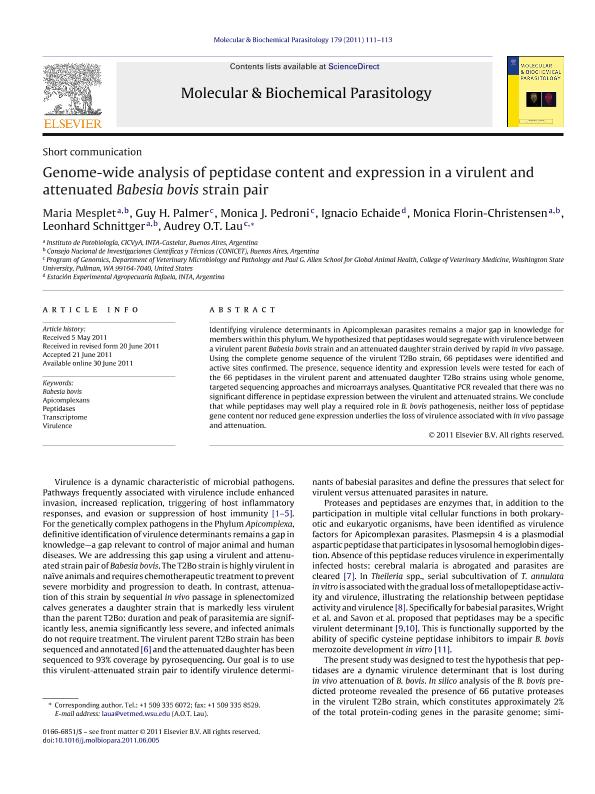Mostrar el registro sencillo del ítem
dc.contributor.author
Mesplet, Maria

dc.contributor.author
Palmer, Guy H.
dc.contributor.author
Pedroni, Monica J.
dc.contributor.author
Echaide, Ignacio Eduardo

dc.contributor.author
Florin Christensen, Monica
dc.contributor.author
Schnittger, Leonhard

dc.contributor.author
Lau, Audrey O. T.
dc.date.available
2023-04-10T11:05:30Z
dc.date.issued
2011-06
dc.identifier.citation
Mesplet, Maria; Palmer, Guy H.; Pedroni, Monica J.; Echaide, Ignacio Eduardo; Florin Christensen, Monica; et al.; Genome-wide analysis of peptidase content and expression in a virulent and attenuated Babesia bovis strain pair; Elsevier Science; Molecular and Biochemical Parasitology; 179; 2; 6-2011; 111-113
dc.identifier.issn
0166-6851
dc.identifier.uri
http://hdl.handle.net/11336/192941
dc.description.abstract
Identifying virulence determinants in Apicomplexan parasites remains a major gap in knowledge for members within this phylum. We hypothesized that peptidases would segregate with virulence between a virulent parent Babesia bovis strain and an attenuated daughter strain derived by rapid in vivo passage. Using the complete genome sequence of the virulent T2Bo strain, 66 peptidases were identified and active sites confirmed. The presence, sequence identity and expression levels were tested for each of the 66 peptidases in the virulent parent and attenuated daughter T2Bo strains using whole genome, targeted sequencing approaches and microarrays analyses. Quantitative PCR revealed that there was no significant difference in peptidase expression between the virulent and attenuated strains. We conclude that while peptidases may well play a required role in B. bovis pathogenesis, neither loss of peptidase gene content nor reduced gene expression underlies the loss of virulence associated with in vivo passage and attenuation.
dc.format
application/pdf
dc.language.iso
eng
dc.publisher
Elsevier Science

dc.rights
info:eu-repo/semantics/openAccess
dc.rights.uri
https://creativecommons.org/licenses/by/2.5/ar/
dc.subject
APICOMPLEXANS
dc.subject
BABESIA BOVIS
dc.subject
PEPTIDASES
dc.subject
TRANSCRIPTOME
dc.subject
VIRULENCE
dc.subject.classification
Otras Ciencias Veterinarias

dc.subject.classification
Ciencias Veterinarias

dc.subject.classification
CIENCIAS AGRÍCOLAS

dc.title
Genome-wide analysis of peptidase content and expression in a virulent and attenuated Babesia bovis strain pair
dc.type
info:eu-repo/semantics/article
dc.type
info:ar-repo/semantics/artículo
dc.type
info:eu-repo/semantics/publishedVersion
dc.date.updated
2023-04-04T12:08:40Z
dc.journal.volume
179
dc.journal.number
2
dc.journal.pagination
111-113
dc.journal.pais
Países Bajos

dc.journal.ciudad
Amsterdam
dc.description.fil
Fil: Mesplet, Maria. Instituto Nacional de Tecnología Agropecuaria. Centro de Investigación en Ciencias Veterinarias y Agronómicas. Instituto de Patobiología; Argentina. Consejo Nacional de Investigaciones Científicas y Técnicas; Argentina
dc.description.fil
Fil: Palmer, Guy H.. Washington State University; Estados Unidos
dc.description.fil
Fil: Pedroni, Monica J.. Washington State University; Estados Unidos
dc.description.fil
Fil: Echaide, Ignacio Eduardo. Instituto Nacional de Tecnología Agropecuaria. Centro Regional Santa Fe. Estación Experimental Agropecuaria Rafaela; Argentina
dc.description.fil
Fil: Florin Christensen, Monica. Instituto Nacional de Tecnología Agropecuaria. Centro de Investigación en Ciencias Veterinarias y Agronómicas. Instituto de Patobiología; Argentina
dc.description.fil
Fil: Schnittger, Leonhard. Instituto Nacional de Tecnología Agropecuaria. Centro de Investigación en Ciencias Veterinarias y Agronómicas. Instituto de Patobiología; Argentina. Consejo Nacional de Investigaciones Científicas y Técnicas; Argentina
dc.description.fil
Fil: Lau, Audrey O. T.. Washington State University; Estados Unidos
dc.journal.title
Molecular and Biochemical Parasitology

dc.relation.alternativeid
info:eu-repo/semantics/altIdentifier/doi/http://dx.doi.org/10.1016/j.molbiopara.2011.06.005
Archivos asociados
